|
Location:
Tyrrhenian Sea, Mediterranean. |
Grid Reference:
Approx centre: 40� N, 9� E. |
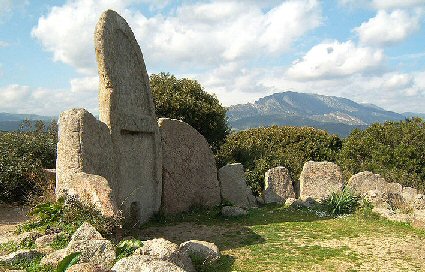
 Sardinia:
(Sardegna)
Sardinia:
(Sardegna)
Sardinia is
currently an autonomous region of Italy and the second largest
island in the Mediterranean after Sicily. Although there is
evidence of human occupation from the Palaeolithic, the island
was only permanently settled from around 6,000 BC in the early
Neolithic,
(1)
probably from Corsica, or the
continent via Corsica.
There are
several distinct forms of Sardinian monuments that dominate
the prehistoric landscape: The Nuraghi, Domus de Janas and the Tombes Gigantes.
(Relief
Map of Sardinia)
|
Tombe di Giganti 'Giant's Tombs': |
The Tombs
of Giants, so called because of their gigantic dimensions, are
another typical element of Sardinia's megalithic period. Usually
the frontal part of their structure is delimited by some sort of
semicircle (exedra), almost as to symbolize a bull's horns (Many
Tombs of Giants are also oriented towards the Taurus'
constellation, precisely towards the brightest star, Aldebaran
(Alpha Tauri). This is the case of the Tombs of �S'Ena e Tomes�
in Dorgali, �Goronna� in Paulilatino and �Baddu Pirastru� in Thiesi (5).
Viewed from above the shape of the Tombs of Giants has also been
said to mind that of an uterus or a woman in labour.
(View
overhead plan)
This interpretation
confirms how closely connected life and death were for nuraghic people and how their
structures were linked to the cult
of fecundation.
The Tombs of Giants are scattered throughout the island. So far about 320
have been found, but it is thought that Sardinia may
still be hiding many more of them.
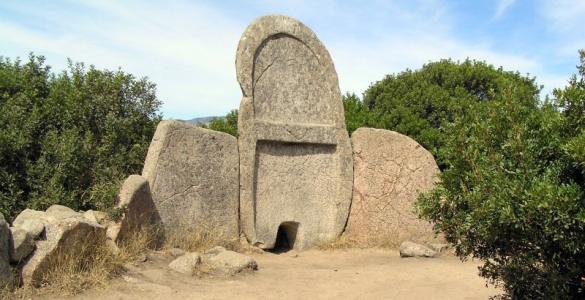
Tomba di Dorgali,
showing closely carved stones at the entrance and a small portal at
the bottom which was carved with what is interpreted as a
representation of a 'false door leading into the other world of the
dead'.


(left) Coddu
Veccio, and (right) Li Goghi, two of the largest Tombs on
Sardinia.

The
Giants Tomb of Olbia (1500
to 1100 BC). The
central stone has been removed revealing
the main structure which lies behind it,
which can only be described as an Al�e Couverte.
The monuments are the result of at least
two stages of development; the first
being the construction of an internal
megalithic burial chamber, and the
second being the external forecourt,
believed to be for congregations, a
similar design as seen in front of the
temples on Malta.
|
Domus de Janas: 'Spirit Houses' or 'Faerie houses'. |

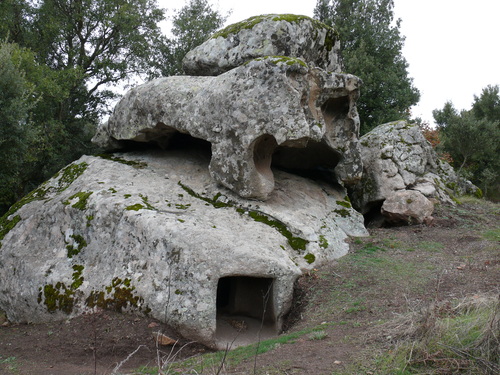
Especially interesting are the tombs known
as domus de janas
(Spirit homes). They
were built by hollowing out large rocks to
form a funeral chamber within, leaving the
natural rock surface to serve as the outer wall.
This one above is on the site of the
S'Ortale e Su Monte/San Salvatore
complex near
Tortol� on the south-eastern coast of the island.
Two
more examples of the aptly named 'Fairy houses'.
The
Roccia dell' Elefante:
This
natural trachyte monolith near Castelsardo has long held an
emblematic presence in the region as there are several
pre-nuraghic domus de Janus carved within its structure.
It is
believed to have long been a significant site as it is located
next to the monument known as 'Multeddu', within which
was found an inscription reminiscent of a temple dedicated to
the Goddess Isis, and a statuette to the goddess Ceres (Now in
the Museo Sanna in Sassari). The chambers are carved with
doorways, with relief frames similar to the chambers of Anghelu
Ruju (below), along with two large curling bull-horns in one of
the chambers.
It is
of course interesting to note that the similarity to an elephant was
presumably recognised over 5,000 years ago, suggesting that the
people who carved it and built the Multeddu next to it must have
already known what an elephant looked like and were therefore
likely to have been regular travellers around the Mediterranean
(i.e. having already been to Africa).
Necropole di Anghelu
Ruju:
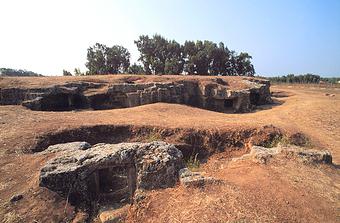 The Necropole di Anghelu
Ruju is the largest ancient burial ground on Sardinia and dates from
3,500-1,800 BC. The Necropole di Anghelu
Ruju is the largest ancient burial ground on Sardinia and dates from
3,500-1,800 BC.
The thirty-six
tombs are cut from or made of sandstone, sharing some common design
features: a series of steps down from the entrance and a descending
passage to a large burial chamber with smaller connecting chambers.
Many of the 36 tombs have doorways carved to simulate trilithons. (A
feature with stark similarities to those seen in the
Hypogeum, on Malta).
Many of the doorways are carved to imitate smoothly
dressed trilithons, but what makes Anghelu Ruju famous are the
carvings of long-horned bulls' heads in and around three of the
tombs (numbered 19, 20 and 30). These symbols were sometimes painted
in red ochre, and they have been interpreted in different ways. It
is worth noting that many of the human bones found in the tombs were
lying under a sheet of white shells; this could indicate that most
of the ancient Sardinians buried here were fishermen.
Among the many grave goods dating from 2200 to 1700 BC found at
Anghelu Ruju, there are obsidian, barbed and flint arrowheads, an
axe and an awl from Ireland, a copper ring from East Europe,
copper daggers from Spain, Beaker pottery, small
marble statuettes, and spiral wire beads. Something which attests to
the strong and extensive trading in operation at that time.
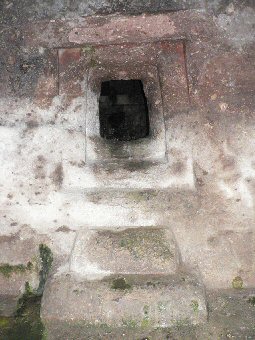
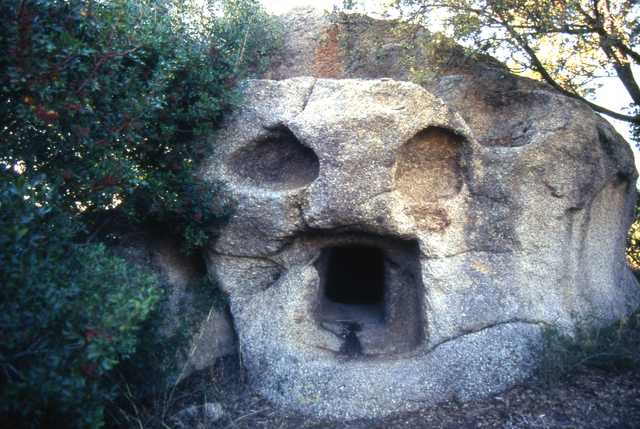

Carved Portals at (Left) Tomba di Santu Pedru, (Right) Anghelu
Ruju.
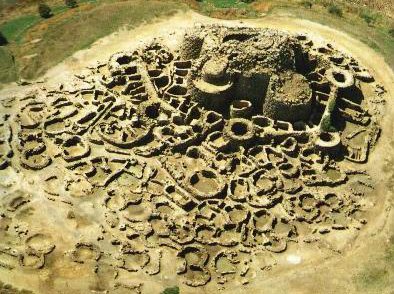 From about 1,500 BC onwards, villages were built
around the round tower-fortresses called nuraghi (Northern Sardinian
nuraghes,
Southern Sardinian nuraxis, plurals of nuraghe and
nuraxi respectively),
which were often reinforced and enlarged with
battlements. The boundaries of tribal territories
were guarded by smaller lookout nuraghi
erected on strategic hills commanding a view of
other territories. Today some 8,000 - 10,000 nuraghi dot the
Sardinian landscape
(4). According to some scholars the nuragic peoples are identifiable with the
Shardana, a tribe of the "Sea
Peoples" (2) From about 1,500 BC onwards, villages were built
around the round tower-fortresses called nuraghi (Northern Sardinian
nuraghes,
Southern Sardinian nuraxis, plurals of nuraghe and
nuraxi respectively),
which were often reinforced and enlarged with
battlements. The boundaries of tribal territories
were guarded by smaller lookout nuraghi
erected on strategic hills commanding a view of
other territories. Today some 8,000 - 10,000 nuraghi dot the
Sardinian landscape
(4). According to some scholars the nuragic peoples are identifiable with the
Shardana, a tribe of the "Sea
Peoples" (2)
They had various rooms and
floors, corridors, cells, internal staircases, even
parapets, for they were true miniature castles,
built to dominate the surrounding countryside.
Architecturally, there are similarities to
structures of the ancient
Mycenaean civilization on
Crete, such as the 'Tholos' - beehive shaped
internal chambers, leading some scholars to believe that these
original Sardinian stonemasons came from that part
of the Mediterranean. The remains of dozens of these
nuraghi are still found throughout the
island, primarily in the north.

(Photo
Credits: Ivo Piras)
The nuraghi at Barumini is the
largest on Sardinia and is located in the
southern part of the island roughly between Oristano
and Caglieri. When it was first rediscovered it was
covered in soil and mistaken for a hill.
To
breach the Nuraghe of Barumini, enemies had to reach a small entrance
located about 7 meters high, making "Su Nuraxi"
in the eyes of the enemy an impenetrable fortress.
Even today, after the excavations carried out by the
archaeologist
Giovanni Lilliu in the 50s, the only entrance
to the fortress is the "sky door". Lilliu's
archaeological excavations proved that Su Nuraxi was
being inhabited until the third century AD.
(3)
(Map
of the Nuraghi on Sardinia)
The Function of the Nuraghi:
There is
no absolute consensus on the function of the
nuraghi: speculation ranges from religious
temples, ordinary dwellings, rulers'
residences, military strongholds,
meeting halls, or a combination of the
former. Some of the nuraghes are,
however, located in strategic locations
� such as hills � from which important
passages could be easily controlled.
They might have been something between a
"status symbol" and a "passive defence"
building, meant to be a deterrent for
possible enemies. It has been noticed
that they are often inter-visible, and
where they are not, smaller intermediate
versions were built, suggesting
continuity for signalling.

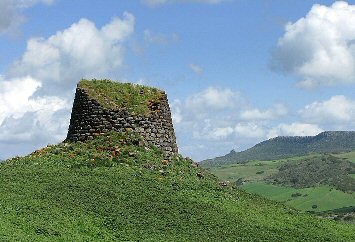
Examples of early or 'simplified' Nuraghi.
Small-scale models of nuraghe have often
been excavated at religious sites (e.g.
in the "maze" temple at the Su Romanzesu
site near Bitti in central Sardinia). Nuraghi
were often located next to temples,
specifically water temples. (This theme
is expanded on below).
The work
of Juan Belmonte and Mauro Zedda has
studied 272 simple and 180 complex
nuraghi; they noted that the orientation
of the door was always turned towards
the south-east, where the sun was known
to rise. Indeed, they argue that several
of the windows in the nuraghi have
solar, lunar and/or stellar alignments.
One such astronomical phenomenon was
observed in the Nuraghe Aiga di
Abbasanta. Here, the summer solstice sun
entered into the construction itself and
creates an impressive solar display.
Such solar alignments argue strongly for
a religious function, if only partial,
as such alignments clearly have no
defensive qualities.
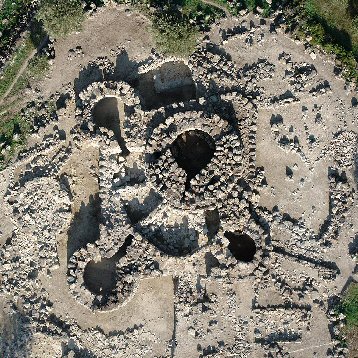
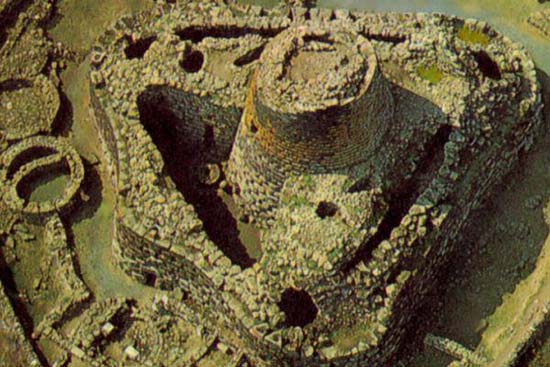
Examples of more
complex Nuraghi.
In the
Bronze age two dramatic events took
place that had their repercussions on
the east and the west Mediterranean,
including Sardinia. The first event was
the decline of the palace culture of the
Minoan period on Crete and the rise of
the Mycenaean's, between 1500 and 1400
BC. The second event was the time of the
incursions of the Sea People in Egypt
and the decline of the Mycenaean palace
culture, around 1200 BC. It was around 1200 BC
that on Sardinia complex nuraghi were
built, an amplification of a central
nuraghe with one or more additional
towers, a small courtyard and even
additional defensive walls and minor
towers. Lilliu has called this period La bella et� dei nuraghi, the climax
of the nuraghe-culture.
Sacred
Wells:
The nuragic well is another important
element of the Sardinian megalithic heritage. At the moment we have
around 40 wells reachable thanks to a monumental staircase after
which there is an atrium (Tholos) for holding the water.
In
the case of the sacred well of
Santa Cristina in Paulilatino-Oristano, it has been
assessed that thanks to the hole situated on the tholos vault, the
moon is reflected on the well. This happens during a predefined
period, that is to say at the utmost declination of the moon, every
18 years and 6 months. Thanks to the staircase, the sun�s light is
reflected in the well during the autumn equinox (between the 22nd
and the 23rd of September) and also during the spring equinox
(between the 20th and the 21st of March).
The moon�s peculiarity has been noticed also in other
wells; also the solar reflection is sometimes visible during the
summer solstice (between the
20th and the 21st of June).
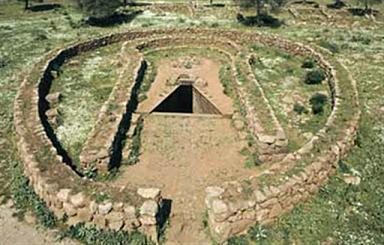
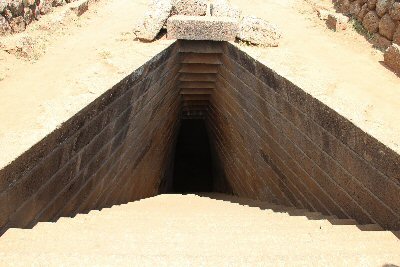
The Santa Christian Sacred well,
exquisitely constructed, and orientated to receive the light from the maximum setting moon on its
18.6 year Lunar cycle.

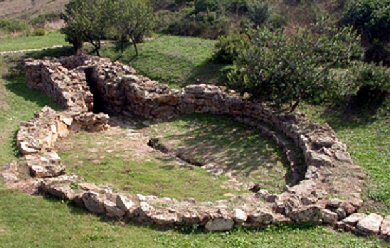
(Left) Pozzo
Sacro di Predio Canopoli, (Right) Posso Sacro di Sa Testa
(Italy
Homepage)
(Malta)
(A-Z
Pages)
(Index
of Sacred Places)
|









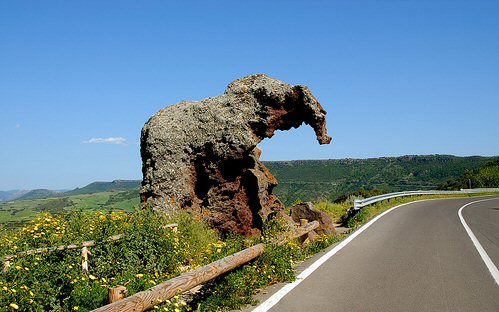

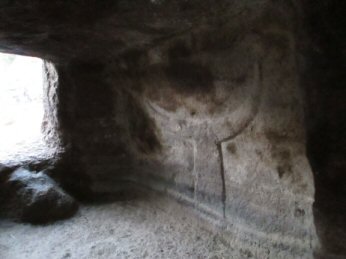




 From about 1,500 BC onwards, villages were built
around the round tower-fortresses called nuraghi (Northern Sardinian
nuraghes,
Southern Sardinian nuraxis, plurals of nuraghe and
nuraxi respectively),
which were often reinforced and enlarged with
battlements. The boundaries of tribal territories
were guarded by smaller lookout nuraghi
erected on strategic hills commanding a view of
other territories. Today some 8,000 - 10,000 nuraghi dot the
Sardinian landscape
(4). According to some scholars the nuragic peoples are identifiable with the
Shardana, a tribe of the "Sea
Peoples" (2)
From about 1,500 BC onwards, villages were built
around the round tower-fortresses called nuraghi (Northern Sardinian
nuraghes,
Southern Sardinian nuraxis, plurals of nuraghe and
nuraxi respectively),
which were often reinforced and enlarged with
battlements. The boundaries of tribal territories
were guarded by smaller lookout nuraghi
erected on strategic hills commanding a view of
other territories. Today some 8,000 - 10,000 nuraghi dot the
Sardinian landscape
(4). According to some scholars the nuragic peoples are identifiable with the
Shardana, a tribe of the "Sea
Peoples" (2)








